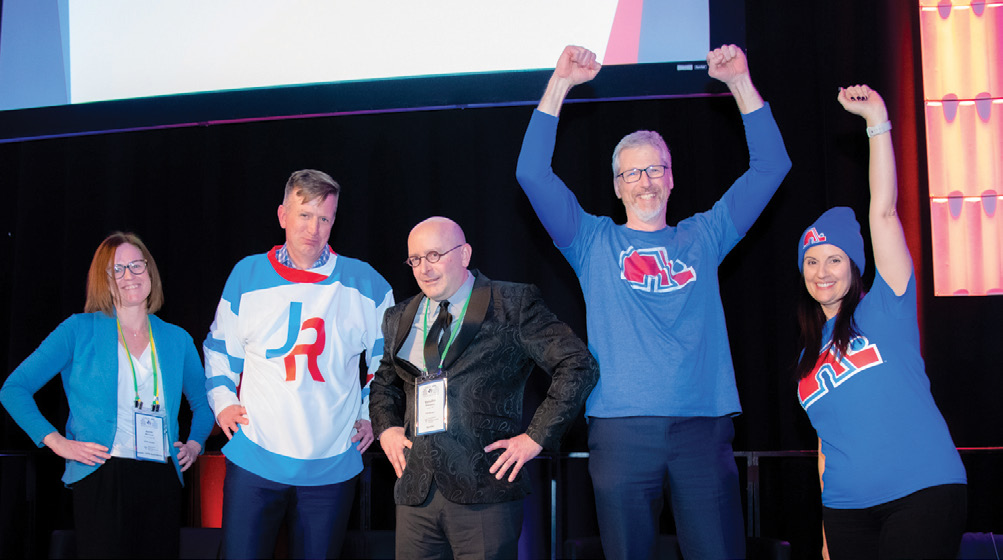Summer 2023 (Volume 33, Number 2)
The Great Debate
By Volodko Bakowsky, MD, FRCPC, on behalf of
Cory Baillie, MD, FRCPC; Louis Bessette, MD, MSc,
FRCPC; Michelle Batthish, MD, MSc, FRCPC; and
Anne MacLeod, PT, MPH, ACPAC
Download PDF

The Great Debate team (from left to right): Anne MacLeod and
Drs. Cory Baillie, Volodko Bakowsky (chair), Louis Bessette, and
Michelle Batthish.
Be it resolved that Canadians with new inflammatory
arthritis should have access to all therapeutic options at
disease onset to induce remission.
One of the nicest things about the CRA Annual Scientific
Meeting once again returning to a live format
was being able to share the stage with some of the
greatest minds in Canadian rheumatologic care for the Great
Debate. These eminent intellectuals were able to present
their arguments in such an approachable fashion that even
the chair (universally accepted as not a great mind) was able
to follow along. The CRA faithful also witnessed the tallest
(Dr. Bessette) and second tallest (Dr. Baillie) Canadian rheumatologists
on stage together at the same time.
Dr. Cory Baillie and Anne MacLeod both spoke in favour
of the motion. In the absence of any guidelines or evidence
to defend their position, the affirmative side was forced to
turn to smoke, mirrors and obfuscation. Among the pillars
of their initial argument was a survey of 39 Canadian rheumatologists
which found that 81% would prefer to be started
on biologic monotherapy or biologic combination therapy
by their rheumatologist if they themselves were diagnosed
with moderate-to-severe rheumatoid arthritis (RA). The affirmative
speakers also presented data about the prevalence
of intolerance to methotrexate and other traditional disease-modifying anti-rheumatic drugs (DMARDs) in adults
and children, the effectiveness of biologics on reducing disability,
the cost savings of both biosimilars and biologic tapering
making early biologic treatment more affordable, and
the amount of general government waste which trivializes
the costs of biologics for rheumatic disease patients.
Canadian data on access to care, in both adult and pediatric
rheumatology, indicate system issues with meeting benchmarks
created by the Wait Time Alliance in 2014. Research
also confirms that wait times in certain urban areas, such as
Toronto, are shorter than elsewhere in the province of Ontario.
Recent studies concluded that there is a trend towards improvements
in access to RA diagnosis and early treatment over time;
however many gaps remain, including suboptimal DMARD
dispensation. In this modern era of advanced therapeutic options,
we still have issues with access to care and timely use of
medications. So, should all Canadians with new inflammatory
arthritis have access to all therapeutic options at disease onset
. . . the answer was suggested to be a resounding yes.
Drs. Louis Bessette and Michelle Batthish spoke against the
motion, and their side certainly benefited from an extensive
body of information to support their argument. According to
them, the current scientific evidence does not support the use
of targeted synthetic/biologic disease-modifying antirheumatic
drugs (ts/bDMARD) as first-line therapy in early inflammatory
arthritis. In treat-to-target (T2T) studies, patients
initially treated with conventional synthetic disease-modifying
antirheumatic drugs (csDMARDs) have similar long-term
clinical disease activity, functional capacity, and joint
damage progression as the groups initially treated with a
ts/bDMARD. Furthermore, starting with a biologic does not
improve the chances of achieving drug-free remission and is
not a cost-effective strategy. According to CATCH (Canadian
early ArthriTis CoHort) data, more than 50% of RA patients
are in remission after one year of using csDMARDs. Moreover,
75% of Canadian RA patients who started csDMARDs as firstline
therapy do not require ts/bDMARDs to control their disease
during the first five years of follow-up. Similarly, in the
CAPRI (Canadian Alliance of Pediatric Rheumatology Investigators)
JIA (juvenile idiopathic arthritis) registry, 81% of
newly diagnosed JIA patients achieve clinically inactive disease
and most are only on a csDMARD.
Safety needs to be considered in this argument as well.
A systematic review revealed that the odds of developing a
serious infection while on a biologic were 1.48 times greater
than while on a csDMARD. In addition, there are no published
guidelines that recommend the use of a ts/bDMARD
as first-line therapy for csDMARD-naive patients. The scientific
evidence shows that starting a csDMARD with a T2T
strategy and adding a ts/bDMARD if necessary, the patient
would have the same chance of achieving disease control
without long-term functional impact as starting with
a ts/bDMARD.
Sadly, all things come to an end (other than advanced
therapy application forms), and it was time to vote. The
winner was decided by an old-fashioned applausometer,
with the “against” side (Drs. Bessette and Batthish) clearly
crowned the winners. However, given the lopsided nature
of the evidence (taking nothing away from Cory Baillie’s
phone-a-friend statistical analysis), the “for” team deserves
a shout-out as well.
Among the cogent arguments were elements of humour
sprinkled throughout, including the requisite poking fun at
Carter Thorne. The Great Debate seeks to achieve a good balance
between science and fun, and this year the debaters
knocked it out of the park.
Volodko Bakowsky, MD, FRCPC
Interim Division Head/Chief, Associate Professor,
Division of Rheumatology, Department of Medicine
Dalhousie University, Halifax, Nova Scotia
|
